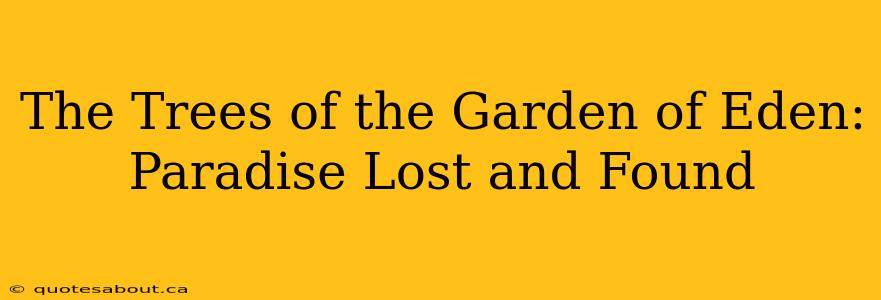The Garden of Eden, a timeless symbol of paradise lost and the potential for redemption, holds a captivating allure for theologians, artists, and readers alike. Central to this evocative imagery are the trees within the garden, each imbued with symbolic weight and theological significance. This exploration delves into the prominent trees of Eden, examining their roles in shaping narratives of creation, temptation, and the enduring hope of restoration.
What are the main trees in the Garden of Eden?
The Bible primarily highlights two trees in the Garden of Eden: the Tree of Life and the Tree of the Knowledge of Good and Evil. While other trees undoubtedly existed, these two hold the most significant narrative weight and theological interpretation. The Tree of Life represents immortality and divine connection, while the Tree of the Knowledge of Good and Evil symbolizes the capacity for independent moral judgment and the consequences of choosing against God's will.
What is the Tree of Life in the Garden of Eden?
The Tree of Life, mentioned throughout scripture (Genesis 2:9, Revelation 2:7, Revelation 22:2), symbolizes eternal life, divine presence, and communion with God. It's not merely a source of physical immortality but represents a deeper spiritual connection, a state of being wholly united with the divine. Access to the Tree of Life was restricted after the Fall, signifying humanity's separation from God's direct grace. However, the promise of eventual restoration and access to the Tree of Life persists throughout biblical narrative, offering a powerful message of hope and redemption.
What is the Tree of the Knowledge of Good and Evil?
The Tree of the Knowledge of Good and Evil, unlike the Tree of Life, represents humanity's capacity for independent moral judgment and the potential for choosing against God's will. Its fruit, consumed by Adam and Eve, brought about the Fall – the loss of innocence, the introduction of sin, and the resulting separation from God's immediate presence. The tree’s significance isn't simply about forbidden knowledge, but about the exercise of free will, a choice that carries profound consequences, both immediate and long-term.
What is the significance of the forbidden fruit?
The nature of the forbidden fruit is a point of ongoing theological debate. While the Bible does not specify the exact type of fruit, its symbolic significance is clear. It represents the allure of autonomy, the tempting desire to be "like God," knowing good and evil independently. The fruit is not inherently evil; it's the act of disobedience, the choice to defy God's clear command, that sets in motion the chain of events leading to humanity's fall from grace. Different interpretations exist, with some suggesting the fruit could be an apple, a fig, or even a symbolic representation of something beyond the physical.
What are the different interpretations of the trees?
Interpretations of the trees' significance vary across theological traditions and throughout history. Some interpret the trees allegorically, while others view them as literal representations. The Tree of Life has been seen as representing Christ, the source of eternal life, and the Tree of Knowledge as symbolizing the allure of worldly wisdom in contrast to divine wisdom. The ongoing debate contributes to the enduring richness and complexity of the Garden of Eden narrative.
What happens to the trees after the Fall?
After the Fall, humanity is banished from the Garden of Eden, losing access to the Tree of Life. This expulsion symbolizes humanity's separation from God's direct presence and the loss of immediate communion. The cherubim guarding the entrance with a flaming sword prevents any return to the Tree of Life, emphasizing the severity of the consequences of disobedience. However, the narrative also suggests the possibility of future restoration, hinted at in the ongoing theme of redemption throughout scripture.
Does the Tree of Life appear in other religious texts?
While the specific imagery of the Tree of Life is predominantly associated with the Judeo-Christian tradition, similar motifs appear in other mythologies and religious traditions. Trees representing immortality, knowledge, and connection to the divine are common recurring symbols in various cultures and belief systems across the globe. These shared symbolic elements highlight the universality of humanity's yearning for understanding, connection, and eternal life. The enduring power of the Tree of Life imagery transcends cultural boundaries and speaks to fundamental human desires.
This exploration of the trees of the Garden of Eden reveals the profound symbolic depth of this timeless narrative. The trees are not merely botanical entities; they are powerful metaphors that explore themes of creation, temptation, free will, and the enduring hope of redemption. Their enduring presence in religious and literary discourse underscores their importance in shaping our understanding of humanity's relationship with the divine and the ongoing quest for paradise.

